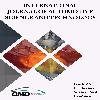Numerical Modeling of Flashing Sprays Using a Hybrid Breakup Model
Numerical Modeling of Flashing Sprays Using a Hybrid Breakup Model
spray, momentum flux, cfd,
___
- [1] Xu, M., Zhang, Y., Zeng, W., Zhang, G., & Zhang, M. (2013). Flash boiling: easy and better way to generate ideal sprays than the high injection pressure. SAE International Journal of Fuels and Lubricants, 6(2013-01-1614), 137-148.
- [2] Ashgriz, N. (Ed.). (2011). Handbook of atomization and sprays: theory and applications. Springer Science & Business Media.
- [3] Huang, C., & Lipatnikov, A. (2011). Modelling of gasoline and ethanol hollow-cone sprays using OpenFOAM (No. 2011-01-1896). SAE Technical Paper.
- [4] Kim, D., & Kim, K. (2014). Comparison of Spray Structures of Diesel and Gasoline Using Modified Evaporation Model in Openfoam CFD Package (No. 2014-01-1417). SAE Technical Paper.
- [5] Yu, S., Yin, B., Jia, H., & Yu, J. (2017). Numerical research on micro diesel spray characteristics under ultra-high injection pressure by Large Eddy Simulation (LES). International Journal of Heat and Fluid Flow, 64, 129-136.
- [6] Kösters, A., & Karlsson, A. (2011). A comprehensive numerical study of diesel fuel spray formation with openfoam (No. 2011-01-0842). SAE Technical Paper.
- [7] Rotondi, R., Hélie, J., Leger, C., Mojtabi, M., & Wigley, G. (2010, September). Multihole gasoline direct injection spray plumes. In 23rd Annual Conference on Liquid Atomization and Spray Systems, Brno, Czech Republic.
- [8] Li, Z. H., He, B. Q., & Zhao, H. (2014). Application of a hybrid breakup model for the spray simulation of a multi-hole injector used for a DISI gasoline engine. Applied Thermal Engineering, 65(1-2), 282-292.
- [9] Zuo, B., Gomes, A. M., & Rutland, C. J. (2000). Modelling superheated fuel sprays and vaproization. International Journal of Engine Research, 1(4), 321-336.
- [10] Price, C., Hamzehloo, A., Aleiferis, P., & Richardson, D. (2015). Aspects of Numerical Modelling of Flash-Boiling Fuel Sprays (No. 2015-24-2463). SAE Technical Paper.
- [11] Chryssakis, C., & Assanis, D. N. (2008). A unified fuel spray breakup model for internal combustion engine applications. Atomization and Sprays, 18(5).
- [12] Huh, K. Y., Lee, E., & Koo, J. (1998). Diesel spray atomization model considering nozzle exit turbulence conditions. Atomization and Sprays, 8(4).
- [13] Som, S., & Aggarwal, S. K. (2010). Effects of primary breakup modeling on spray and combustion characteristics of compression ignition engines. Combustion and Flame, 157(6), 1179-1193.
- [14] Cavicchi, A., Postrioti, L., Giovannoni, N., Fontanesi, S., Bonandrini, G., & Di Gioia, R. (2017). Numerical and experimental analysis of the spray momentum flux measuring on a GDI injector. Fuel, 206, 614-627.
- [15] O'Rourke, P. J., & Amsden, A. A. (1987). The TAB method for numerical calculation of spray droplet breakup (No. 872089). SAE Technical Paper.
- [16] Reitz, R. D., & Diwakar, R. (1986). Effect of drop breakup on fuel sprays (No. 860469). SAE Technical Paper.
- [17] Rotondi, R., & Bella, G. (2006). Gasoline direct injection spray simulation. International Journal of Thermal Sciences, 45(2), 168-179.
- [18] Rotondi, R. (2006). Modeling mixture formation in a gasoline direct injection engine. Journal of applied mechanics, 73(6), 931-939.
- [19] Reitz, R. D. (1990). A photographic study of flash-boiling atomization. Aerosol Science and Technology, 12(3), 561-569.
- [20] Postrioti, L., Bosi, M., Cavicchi, A., AbuZahra, F., Di Gioia, R., & Bonandrini, G. (2015). Momentum Flux Measurement on Single-Hole GDI Injector under Flash-Boiling Condition (No. 2015-24-2480). SAE Technical Paper.
- [21] Pilch, M., & Erdman, C. A. (1987). Use of breakup time data and velocity history data to predict the maximum size of stable fragments for acceleration-induced breakup of a liquid drop. International journal of multiphase flow, 13(6), 741-757.
- [22] Bell, I. H., Wronski, J., Quoilin, S., & Lemort, V. (2014). Pure and pseudo-pure fluid thermophysical property evaluation and the open-source thermophysical property library CoolProp. Industrial & engineering chemistry research, 53(6), 2498-2508.
- Yayın Aralığı: 4
- Başlangıç: 2016
- Yayıncı: Otomotiv Mühendisleri Derneği
CFD Analysis of a Backward Facing Step Flows
Thabit THABİT, Senan THABET, Yaser JASİM
Numerical Modeling of Flashing Sprays Using a Hybrid Breakup Model
Yağmur GÜLEÇ, Alvaro DIEZ, Francesco CONTINO
Heat Transfer Correlations on Combustion Chamber Surface of Diesel Engine - Experimental Work
Shiva KUMAR, Ajeet KUMAR, Abhilash Rai SHARAMA, Amit KUMAR
